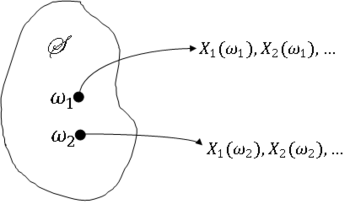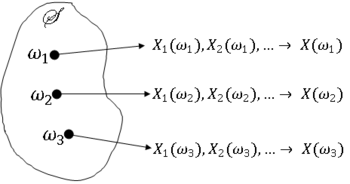| Line 138: | Line 138: | ||
==Cauchy Criterion for Convergence== | ==Cauchy Criterion for Convergence== | ||
| − | We will now discuss a method | + | We will now discuss a method for showing that X<math>_n</math> → X in the mean square sense for some random variables X without knowing what X is. Frist, consider a sequence of real numbers. |
| + | |||
| + | '''Definition''' If x<math>_n</math> is a sequence of real numbers and <br/> | ||
| + | <center><math>|x_{m+n}-x_n|\rightarrow 0</math><br/> | ||
| + | as<br/> | ||
| + | <math>n\rightarrow \infty \quad \forall m>0</math></center> | ||
| + | |||
| + | then x<math>_n</math> converges iff it is a Cauchy sequence. This is known as the Cauchy criterion for convergence. | ||
| + | |||
| + | '''The Cauchy Criterion for mean square convergence of X<math>_n</math>''' <math>\qquad</math> | ||
Revision as of 10:09, 22 November 2013
Random Variables and Signals
Topic 18: Stochastic Convergence
Stochastic Convergence
We will now consider infinite sequences of random variables. We will discuss what it means for such a sequence to converge. This will lead to some very important results: the laws of large numbers and the Central Limit Theorem.
Consider a sequence X$ _1 $,X$ _2 $,..., where each X$ _i $ is a random variable on (S,F,P). We will call this a random sequence (or a discrete-time random process).
Notation $ \qquad $ X$ _n $ may refer to either the sequence itself or to the nth element in the sequence. We may also use {X$ _n $} to denote the sequence, or X$ _n $, n ≥ 1.
The sequence X$ _n $ maps S to the set of all sequences of real numbers, so for a fixed S, X$ _1(\omega) $,X$ _2(\omega) $,... is a sequence of real numbers.
Before looking at convergence, recall the meaning of convergence or a sequence of real numbers.
Definition $ \qquad $ A sequence of real numbers x$ _1 $,x$ _2 $,... converges to a number x ∈ R if ∀$ \epsilon $ > 0, ∃ an n$ _{\epsilon} $ ∈ N such that
If there is such an x ∈ R, we say
or
For a random sequence X$ _n $, the issue of convergence is more complicated since X$ _n $ is a function of $ \omega $ ∈ S.
First look at a motivating example.
Example $ \qquad $ Let X$ _k $ = s + W$ _k $, where s ∈ R and W$ _k $ is a random sequence with E[W$ _k $] = 0 ∀k = 1,2,.... W$ _k $ can be viewed as a noise sequence if we want to know the value of s.
Let
Then, E[Y$ _n $] = s ∀n. But Y$ _n $ is a random variable, so we cannot expect Y$ _n $ = s ∀n. However, we intuitively expect Y$ _n $ to be a better estimate of s as n increases. Does Y$ _n $ → s as n → ∞ ? If so, in what sense?
Types of Convergence
Since X$ _n(\omega) $ is generally a different sequence for very $ \omega $ ∈ S, what does it mean for X$ _n $ to converge? We will discuss different ways in which X$ _n $ can converge.
Definition $ \qquad $ X$ _n $ converges everywhere if the sequence X$ _1(\omega) $,X$ _2(\omega) $,... converges to some value X$ (\omega) $ ∀$ \omega $ ∈ S. We also call this sure convergence or convergence surely.
Notation
Definition $ \qquad $ X$ _n $ converges almost everywhere or almost surely, if X$ _n(\omega) $ → for some A ∈ S with P(A) = 1. Also known as convergence with probability 1.
Notation
Definition $ \qquad $ X$ _n $ converges in mean square to X if
as
Notation
Definition X$ _n $ converges in probability to X if ∀$ \epsilon $ > 0
as
Note that P(|X$ _n $ - X| > $ \epsilon $) is a sequence of real numbers.
Notation
Definition $ \qquad $ X$ _n $ converges in distribution to X if
as
Note that for a fixed x ∈ R, F$ _n $(x) is a sequence of real numbers.
Notation
We will generally assume that if X$ _n $ converges in distribution, then
or
$ f_{X_n}(x)\rightarrow f_X(x) $
as
although this is not true in every instance, as seen in the next example.
Example $ \qquad $ Let X$ _n $ have pdf
Then
Now
as
$ n\rightarrow\infty $
where
However, f$ _{Xn} $ does not converge for x ∈ (0,1).
Cauchy Criterion for Convergence
We will now discuss a method for showing that X$ _n $ → X in the mean square sense for some random variables X without knowing what X is. Frist, consider a sequence of real numbers.
Definition If x$ _n $ is a sequence of real numbers and
as
then x$ _n $ converges iff it is a Cauchy sequence. This is known as the Cauchy criterion for convergence.
The Cauchy Criterion for mean square convergence of X$ _n $ $ \qquad $



